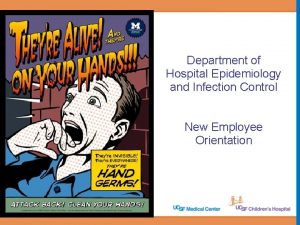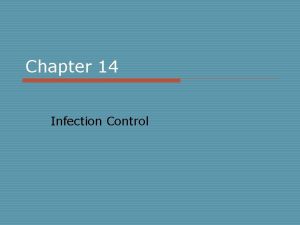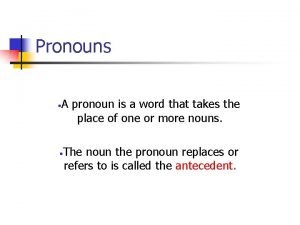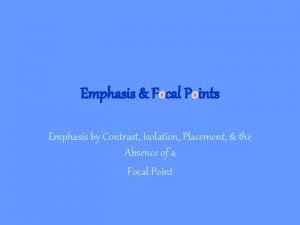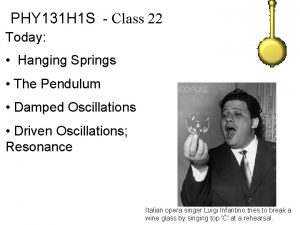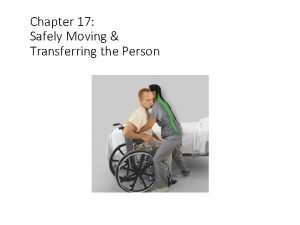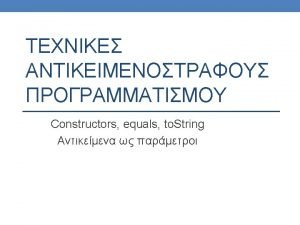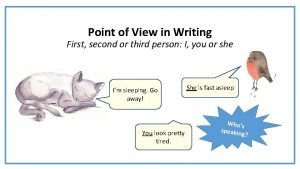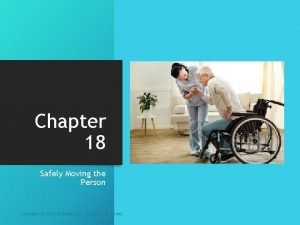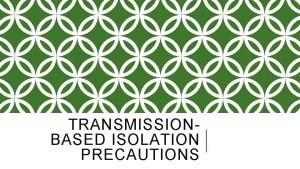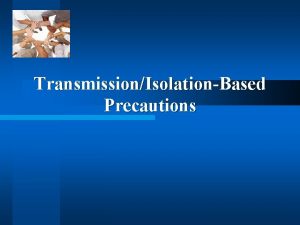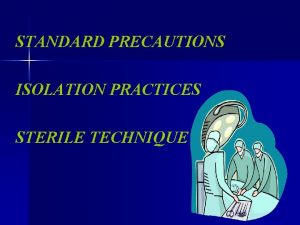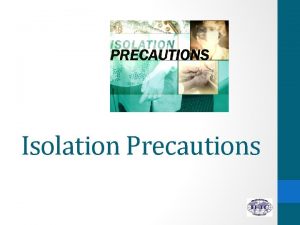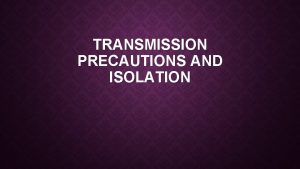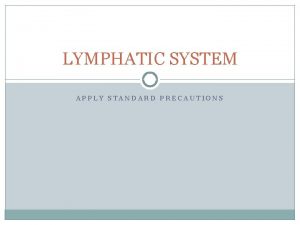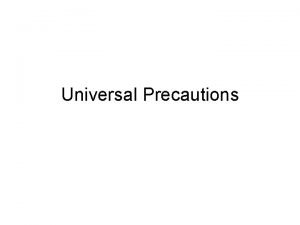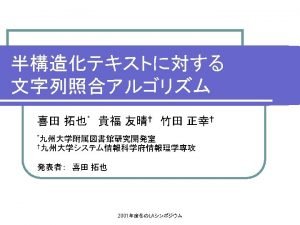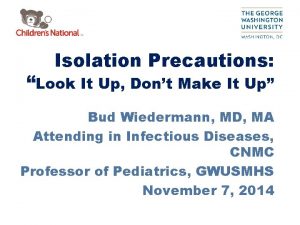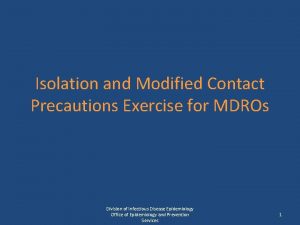ISOLATION PRECAUTIONS ISOLATION The separation of a person



































- Slides: 35


ISOLATION PRECAUTIONS

ISOLATION The separation of a person with infectious disease from contact with other human beings for the period of communicability MC-ICD-P/22

TRANSMISSION-BASED PRECAUTIONS Airborne Precautions Droplet Precautions Contact Precautions

AIRBORNE PRECAUTIONS Causative agents of diseases under airborne precaution are less than 5 μm, thus can be carried away by air currents

DISEASES UNDER AIRBORNE PRECAUTION • Measles • Tuberculosis (Pulmonary/Laryngeal) • Varicella

AIRBORNE PRECAUTIONS Patient Placement • Single room with negative air pressure • 12 air exchanges per hour(MOH) • Room door closed • MC-ICD-P/43

AIRBORNE PRECAUTIONS Protection for HCW üStandard Precautions üN 95 respirator Patient Transport ü Limit movement ü Mask the patient with surgical mask

AIRBORNE PRECAUTIONS • N 95 mask is single use

FIT TEST MC-ICD-P/26

For Airborne Precautions • N 95 respirator Well sealed check MC-ICD-P/05

Powered Air purifying respirator (PAPR)

13

AIRBORNE PRECAUTIONS Display sign outside the door. Remove sign after room is cleaned. Common Conditions: Pulmonary or Laryngeal Tuberculosis Chicken Pox Disseminated Herpes Zoster (Shingles) Rubeola (Measles) Avian Influenza Family and other visitors to follow precautions Airborne Infection Isolation Room Use Airborne Isolation room. Nurse to notify Infection Control Preventionist and Facilities/Engineering of room number when starting and stopping precautions Dishes / Utensils: No special precautions. Kitchenware sanitized in dishwasher. Equipment / Supplies: Use dedicated or disposable equipment when available. Clean and disinfect reusable equipment including IV pumps, cell phone, or pagers (if used in room), other electronics, supplies and equipment prior to removing from patient’s room. Ensure blood pressure cuff and stethoscope are cleaned and disinfected between patients. Only essential supplies in room. Linen Management: Bag linen in the patient’s room. Patient Identification Procedure: Use patient’s label for validation of patient identity and destroy in room after use. Personal Protective Equipment (PPE) Put ON in order: 1. 2. Take OFF & dispose outside room, in order 1. 2. Wash or sanitize hands Fitted N-95, 99, 100 respirator or PAPR required Fitted N-95, 99, 100 respirator or PAPR Wash or sanitize hands (even if gloves used) Room Cleaning: After patient is discharged, keep door closed for one hour to allow complete room air exchange before routine cleaning procedures. Change cubicle curtain if visibly soiled. Transport: Essential transport only and place surgical mask on patient. Clean and disinfect transport vehicle. Alert receiving department regarding patient’s isolation precaution status. Discontinue precautions as per hospital policy or Infection Preventionist Instructions. 14


Discontinuation of isolation precautions Tuberculosis • Laryngeal/Pulmonary TB with positive smear sputum sample for acid fast bacilli is transmitted by airborne. • After 2 weeks from starting effective treatment, 3 sputum samples (with 8 hours in between & at least one morning sample) should be negative to discontinue the isolation. • MC-ICD-P/19

DROPLET PRECAUTIONS Causative agents of diseases under droplet precaution are greater than 5 μm. They can travel up to 3 feet (1 mtr)

DISEASES UNDER DROPLET PRECAUTION • Haemophilus influenzae type B disease, including meningitis, pneumonia, epiglottis and sepsis • Streptococcal (group A) pharyngitis, scarlet fever in infants and young children • Influenza, Mumps

DROPLET PRECAUTIONS Patient placement • Private • Cohort room nursing

DROPLET PRECAUTIONS Protection for HCW • Standard • Surgical precautions mask if working within 3 feet of the patient Patient Transport • Limit movement • Mask the patient surgical mask with

21

DROPLET PRECAUTIONS Display sign outside the door. Remove sign after room is cleaned. Common Conditions: Seasonal Influenza Bacterial Meningitis (N. meningitides) Pertussis (Whooping Cough) Mumps Family and other visitors to follow precautions Dishes / Utensils: No special precautions. Kitchenware sanitized in dishwasher. Equipment / Supplies: Use dedicated or disposable equipment when available. Clean and disinfect reusable equipment including IV pumps, cell phone, or pagers (if used in room), other electronics, supplies and equipment prior to removing from patient’s room. Ensure blood pressure cuff and stethoscope are cleaned and disinfected between patients. Only essential supplies in room. Linen Management: Bag linen in the patient’s room. Patient Identification Procedure: Use patient’s label for validation of patient identity and destroy in room after use. Personal Protective Equipment (PPE) Put ON in order: 1. 2. 3. 4. 5. Wash or sanitize hands Gown (if needed) Mask Eye cover Gloves (if needed) Take OFF & dispose outside room, in order 1. 2. 3. 4. 5. Gloves (if used) Eye cover Gown (if used) Mask Wash or sanitize hands (even if gloves used) Private Room: If not available, room with patient that has the same organism but no other infection. Transport: Essential transport only and place surgical mask on patient. Clean and disinfect transport vehicle. Alert receiving department regarding patient’s isolation precaution status. Discontinue precautions as per hospital policy or Infection Preventionist Instructions. 22


Discontinuation of isolation precautions Influenza 24 h after resolution of fever, provided ■ Have received 72 hours of anti-influenza OR ■ 5 days have elapsed since onset of symptoms. • NO need to repeating the nasopharyngeal swab. Performing aerosol-generating procedures: • Standard & airborne precautions are recommended • MC-ICD-P/02

CONTACT PRECAUTIONS Use In addition to standard precaution, for patients known or suspected to have serious illness transmitted through contact

CONTACT PRECAUTIONS • Direct Contact Transmission In-Direct Contact

DISEASES UNDER CONTACT PRECAUTION • Multi-drug resistant microorganisms (MDRO’s), VRE, MRSA, ESBL, B. cepacia • RSV infection in infants, young childrena nd immunocompromised patients • Clostridium defficile enterocolitis

CONTACT PRECAUTIONS Patient placement • Private room • Cohort nursing

CONTACT PRECAUTIONS Protection for HCW • Handwashing • Gloves • Gown Patient Transport • Limit movement

30

CONTACT PRECAUTIONS Display sign outside the door. Remove sign after room is cleaned. Common Conditions: Multi-Drug Resistant Organism ü Methicilline Resistant Staphylococcus Aureus (MRSA ü Vancomycin Resistant Enterococcus (VRE) Clostridium Difficile Infection (C. Diff) Scabies Wounds or abscesses with uncontained drainage Family and other visitors to follow precautions Dishes / Utensils: No special precautions. Kitchenware sanitized in dishwasher. Equipment / Supplies: Use dedicated or disposable equipment when available. Clean and disinfect reusable equipment including IV pumps, cell phone, or pagers (if used in room), other electronics, supplies and equipment prior to removing from patient’s room. Ensure blood pressure cuff and stethoscope are cleaned and disinfected between patients. Only essential supplies in room. Linen Management: Bag linen in the patient’s room. Patient Identification Procedure: Use patient’s label for validation of patient identity and destroy in room after use. Personal Protective Equipment (PPE) Put ON in order: 1. 2. 3. 4. 5. Take OFF & dispose outside room, in order Wash or sanitize hands Gown Mask (if needed) Eye cover (if needed) Gloves 1. 2. 3. 4. 5. Gloves Eye cover (if used) Gown Mask (if used) Wash or sanitize hands (even if gloves used) Private Room: If not available, room with patient that has the same organism but no other infection. Transport: Essential transport only. Place patient in clean gown. Clean and disinfect transport vehicle. Alert receiving department regarding patient’s isolation precaution status. Discontinue precautions as per hospital policy or Infection Preventionist Instructions. 31


Discontinuation of isolation precautions MDRO • All Colonization/Infection patients with MDRO should be under Contact Isolation. • Isolation can be discontinued after receiving 3 negative lab result 48 hrs after antimicrobial discontinuation • MC-ICD-P/23 &44

EMPIRIC ISOLATION PRECAUTIONS • The risk of infection transmission may be highest before a definitive diagnosis can be reached • Therefore, patients with certain clinical syndromes should be isolated empirically until we have a definitive diagnosis.

THANK YOU!!!!
 Standard precautions and transmission-based precautions
Standard precautions and transmission-based precautions Droplet isolation precautions
Droplet isolation precautions Maintaining transmission based isolation precautions
Maintaining transmission based isolation precautions Example of personal pronoun
Example of personal pronoun 2.person singular
2.person singular 1st person 2nd person 3rd person
1st person 2nd person 3rd person Person person = new person()
Person person = new person() Emphasis by separation and isolation
Emphasis by separation and isolation Person a and person b
Person a and person b Person-job fit and person-organization fit
Person-job fit and person-organization fit A person's trash is another person's treasure
A person's trash is another person's treasure Biography features
Biography features A person swings on a swing when the person sits still
A person swings on a swing when the person sits still Satire in fahrenheit 451
Satire in fahrenheit 451 When transferring a person
When transferring a person We is second or third person
We is second or third person Hello dear warm greetings how are you doing ?
Hello dear warm greetings how are you doing ? Private string name java
Private string name java Excerpt from the car by gary paulsen answer key
Excerpt from the car by gary paulsen answer key First person vs third person writing
First person vs third person writing When a person is logrolled the person is
When a person is logrolled the person is Gấu đi như thế nào
Gấu đi như thế nào Thiếu nhi thế giới liên hoan
Thiếu nhi thế giới liên hoan điện thế nghỉ
điện thế nghỉ Một số thể thơ truyền thống
Một số thể thơ truyền thống Thế nào là hệ số cao nhất
Thế nào là hệ số cao nhất Trời xanh đây là của chúng ta thể thơ
Trời xanh đây là của chúng ta thể thơ Slidetodoc
Slidetodoc Bảng số nguyên tố lớn hơn 1000
Bảng số nguyên tố lớn hơn 1000 đặc điểm cơ thể của người tối cổ
đặc điểm cơ thể của người tối cổ Vẽ hình chiếu vuông góc của vật thể sau
Vẽ hình chiếu vuông góc của vật thể sau Các châu lục và đại dương trên thế giới
Các châu lục và đại dương trên thế giới Glasgow thang điểm
Glasgow thang điểm ưu thế lai là gì
ưu thế lai là gì Hệ hô hấp
Hệ hô hấp Tư thế ngồi viết
Tư thế ngồi viết

